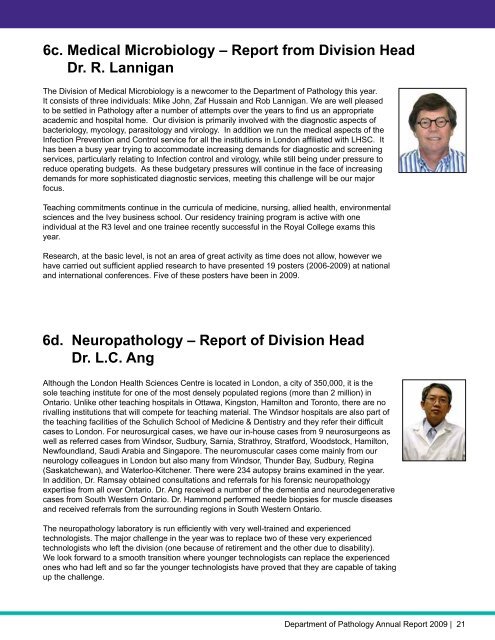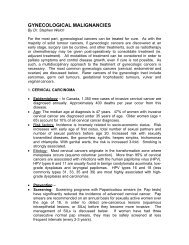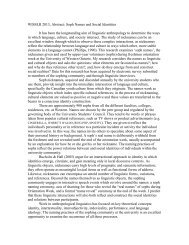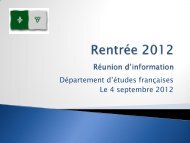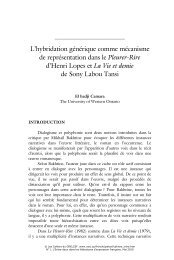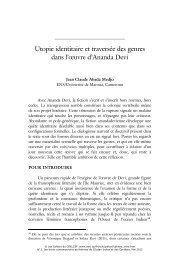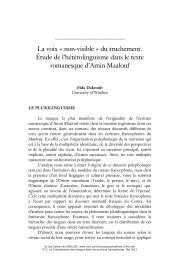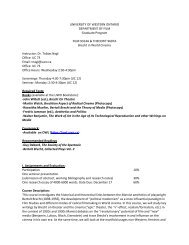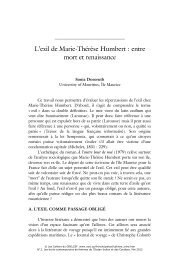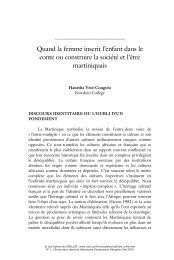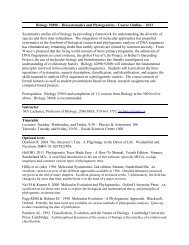Department of Pathology ANNUAL REPORT 2009 - University of ...
Department of Pathology ANNUAL REPORT 2009 - University of ...
Department of Pathology ANNUAL REPORT 2009 - University of ...
You also want an ePaper? Increase the reach of your titles
YUMPU automatically turns print PDFs into web optimized ePapers that Google loves.
6c. Medical Microbiology – Report from Division Head<br />
Dr. R. Lannigan<br />
The Division <strong>of</strong> Medical Microbiology is a newcomer to the <strong>Department</strong> <strong>of</strong> <strong>Pathology</strong> this year.<br />
It consists <strong>of</strong> three individuals: Mike John, Zaf Hussain and Rob Lannigan. We are well pleased<br />
to be settled in <strong>Pathology</strong> after a number <strong>of</strong> attempts over the years to find us an appropriate<br />
academic and hospital home. Our division is primarily involved with the diagnostic aspects <strong>of</strong><br />
bacteriology, mycology, parasitology and virology. In addition we run the medical aspects <strong>of</strong> the<br />
Infection Prevention and Control service for all the institutions in London affiliated with LHSC. It<br />
has been a busy year trying to accommodate increasing demands for diagnostic and screening<br />
services, particularly relating to Infection control and virology, while still being under pressure to<br />
reduce operating budgets. As these budgetary pressures will continue in the face <strong>of</strong> increasing<br />
demands for more sophisticated diagnostic services, meeting this challenge will be our major<br />
focus.<br />
Teaching commitments continue in the curricula <strong>of</strong> medicine, nursing, allied health, environmental<br />
sciences and the Ivey business school. Our residency training program is active with one<br />
individual at the R3 level and one trainee recently successful in the Royal College exams this<br />
year.<br />
Research, at the basic level, is not an area <strong>of</strong> great activity as time does not allow, however we<br />
have carried out sufficient applied research to have presented 19 posters (2006-<strong>2009</strong>) at national<br />
and international conferences. Five <strong>of</strong> these posters have been in <strong>2009</strong>.<br />
6d. Neuropathology – Report <strong>of</strong> Division Head<br />
Dr. L.C. Ang<br />
Although the London Health Sciences Centre is located in London, a city <strong>of</strong> 350,000, it is the<br />
sole teaching institute for one <strong>of</strong> the most densely populated regions (more than 2 million) in<br />
Ontario. Unlike other teaching hospitals in Ottawa, Kingston, Hamilton and Toronto, there are no<br />
rivalling institutions that will compete for teaching material. The Windsor hospitals are also part <strong>of</strong><br />
the teaching facilities <strong>of</strong> the Schulich School <strong>of</strong> Medicine & Dentistry and they refer their difficult<br />
cases to London. For neurosurgical cases, we have our in-house cases from 9 neurosurgeons as<br />
well as referred cases from Windsor, Sudbury, Sarnia, Strathroy, Stratford, Woodstock, Hamilton,<br />
Newfoundland, Saudi Arabia and Singapore. The neuromuscular cases come mainly from our<br />
neurology colleagues in London but also many from Windsor, Thunder Bay, Sudbury, Regina<br />
(Saskatchewan), and Waterloo-Kitchener. There were 234 autopsy brains examined in the year.<br />
In addition, Dr. Ramsay obtained consultations and referrals for his forensic neuropathology<br />
expertise from all over Ontario. Dr. Ang received a number <strong>of</strong> the dementia and neurodegenerative<br />
cases from South Western Ontario. Dr. Hammond performed needle biopsies for muscle diseases<br />
and received referrals from the surrounding regions in South Western Ontario.<br />
The neuropathology laboratory is run efficiently with very well-trained and experienced<br />
technologists. The major challenge in the year was to replace two <strong>of</strong> these very experienced<br />
technologists who left the division (one because <strong>of</strong> retirement and the other due to disability).<br />
We look forward to a smooth transition where younger technologists can replace the experienced<br />
ones who had left and so far the younger technologists have proved that they are capable <strong>of</strong> taking<br />
up the challenge.<br />
<strong>Department</strong> <strong>of</strong> <strong>Pathology</strong> Annual Report <strong>2009</strong> | 21


